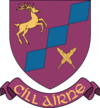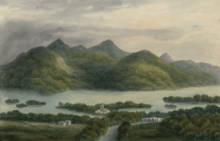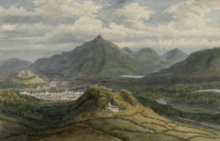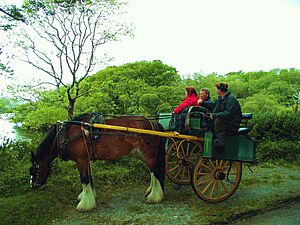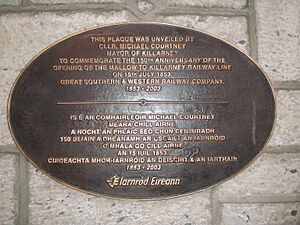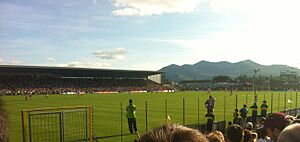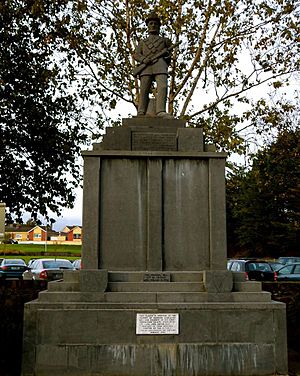Killarney facts for kids
Quick facts for kids
Killarney
Cill Airne
|
||
|---|---|---|
|
Town
|
||
|
From top, left to right: St Mary's Cathedral, High Street, Red Deer sculpture, Killarney House garden
|
||
|
||
| Country | Ireland | |
| Province | Munster | |
| County | Kerry | |
| Council | Kerry County Council | |
| Dáil Éireann | Kerry | |
| European Parliament | South | |
| Elevation | 50 m (160 ft) | |
| Population
(2022)
|
||
| • Total | 14,412 | |
| Time zone | UTC±0 (WET) | |
| • Summer (DST) | UTC+1 (IST) | |
| Eircode routing key |
V93
|
|
| Telephone area code | +353(0)64 | |
| Irish Grid Reference | V969909 | |
Killarney (pronounced kil-AR-nee) is a lively town in County Kerry, located in the southwest of Ireland. Its name comes from the Irish words Cill Airne, which means 'church of sloes'. The town sits right on the edge of Lough Leane, which is part of the beautiful Killarney National Park.
Killarney is famous for its stunning natural beauty and important historical sites. You can find places like St Mary's Cathedral, Ross Castle, Muckross House and Muckross Abbey, the famous Lakes of Killarney, and impressive mountains like MacGillycuddy's Reeks. There's also the amazing Gap of Dunloe and Torc Waterfall. Because of its rich history and location on the popular Ring of Kerry driving route, Killarney is a very popular place for tourists to visit.
In 2022, about 14,412 people lived in Killarney, making it the second-largest town in County Kerry. Killarney has won awards for being a well-kept and tidy town. In 2007, it won the "Best Kept Town" award, and in 2011, it was named Ireland's tidiest and cleanest town.
Contents
Killarney's Past: A Journey Through Time
Early Beginnings and Growth
Killarney has a long and interesting history, especially with religious communities. One of the first important settlements was a monastery built on Innisfallen Island in 640 AD by St. Finian the Leper. Monks lived there for about 850 years.
Innisfallen Island is in Lough Leane, one of the three Lakes of Killarney. The old ruins of Innisfallen Abbey are still there. The monks lived there until 1594, when Queen Elizabeth I of England took their land. It's said that Brian Boru, a famous Irish High King, went to school at Innisfallen.
Another important historical place is Aghadoe, which overlooks Killarney today. It might have been a pagan religious site long ago. Some old stones from the 7th century show that Aghadoe was an important spot. A legend says that St. Finian also started a monastery there. The first written record of this monastery is from 939 AD.
After the Normans came to Ireland in 1169, they built Parkavonear Castle in Aghadoe. This castle was probably an early lookout point because it had great views of the Killarney valley and lakes.
Ross Castle was built by the O'Donoghues Mor family in the late 1400s, right on the lake shore. Later, during the Desmond Rebellions in the 1580s, the Mac Carty Mor family took control of the castle.
Muckross Abbey was founded in 1448 by Donal McCarthy Mor for Franciscan friars. A friary is a type of monastery where monks live. Sadly, the abbey was burned down in 1654 by forces led by General Ludlow. Today, it remains a beautiful ruin.
Killarney played a big part in the Irish War of Independence. The town and the whole county had strong ties to the Irish Republican cause, and there were often fights with the British forces. The Great Southern Hotel was even used by the British as an office and barracks. One famous event was the Headford Ambush, where the IRA attacked a train near the town.
After the war, there were disagreements among former friends, and Killarney suffered during the Irish Civil War. For example, five Republican prisoners were killed in Killarney by Free State forces a day after another sad event called the Ballyseedy massacre.
Killarney used to have its own town council, but in 2014, it became part of the larger Kerry County Council.
| Historical population | ||
|---|---|---|
| Year | Pop. | ±% |
| 1821 | 7,014 | — |
| 1831 | 7,910 | +12.8% |
| 1841 | 7,127 | −9.9% |
| 1851 | 5,901 | −17.2% |
| 1861 | 5,204 | −11.8% |
| 1871 | 5,195 | −0.2% |
| 1881 | 6,651 | +28.0% |
| 1891 | 5,510 | −17.2% |
| 1901 | 5,656 | +2.6% |
| 1911 | 5,796 | +2.5% |
| 1926 | 5,328 | −8.1% |
| 1936 | 5,609 | +5.3% |
| 1946 | 5,947 | +6.0% |
| 1951 | 6,298 | +5.9% |
| 1956 | 6,464 | +2.6% |
| 1961 | 6,825 | +5.6% |
| 1966 | 6,877 | +0.8% |
| 1971 | 7,541 | +9.7% |
| 1981 | 9,083 | +20.4% |
| 1986 | 10,189 | +12.2% |
| 1991 | 9,950 | −2.3% |
| 1996 | 12,011 | +20.7% |
| 2002 | 13,167 | +9.6% |
| 2006 | 14,603 | +10.9% |
| 2011 | 14,219 | −2.6% |
| 2016 | 14,504 | +2.0% |
| 2022 | 14,412 | −0.6% |
How Tourism Grew in Killarney
People have been visiting Killarney for fun since the mid-1700s. Lord Kenmare started to encourage visitors and new residents to the town around 1747. A very important event for Killarney was when Queen Victoria visited in 1861. This visit helped make the town famous around the world.
Killarney became even more popular when the railway arrived in July 1853. Before the railway, there were only a few hotels. But just one year later, in 1854, there were seven hotels! These hotels were located near the railway station, on the main street, and close to the beautiful lakes.
By 1858, tours of the Ring of Kerry were already a big deal, and Killarney was the starting point for this 110-mile (175 km) journey. People were amazed by how strong the horses were, pulling carriages for long distances over several days. Travelers were advised to hire a carriage in Killarney and keep it for the whole trip around the Ring.
Killarney's Economy: How the Town Makes a Living
Local Industries
In the 1740s, Thomas Browne, 4th Viscount Kenmare started linen factories in Killarney to help the town grow. Later, making hosiery (socks and stockings) and shoes became important industries. One shoe factory, Hillards, once employed 250 people.
Today, modern companies like Liebherr Cranes have a big presence in Killarney. They have been there since 1958, making large container cranes and doing research. There's even a street named Hans Liebherr Road after the company's founder. Another company, Tricel (also known as Killarney Plastics), started in 1973.
Government offices also provide jobs in Killarney, including parts of the Department of Tourism, Culture, Arts, Gaeltacht, Sport and Media and the Department of Justice.
Tourism: Killarney's Biggest Business
Tourism is the most important industry in Killarney. It brings in about €410 million every year! Around 1.1 million tourists visit the town annually, and more than 60% of them come from other countries.

In 2023, Killarney became the first town in Ireland to stop the use of single-use coffee cups. This was done to help reduce litter during the busy tourist season.
Getting Around Killarney
Road Travel
Killarney is connected by important roads. The N22 goes north to Tralee and east to Cork. The N72 goes west to Killorglin and east towards Mallow. The N71 heads south to Kenmare and Bantry.
Train Services
Killarney railway station has direct train services to Tralee, Cork, and Dublin. You can also connect to other parts of the train network from there.
Bus Services
Bus Éireann offers bus services from Killarney to Limerick (and then to Dublin), Tralee, Cork, Kenmare, and Skibbereen.
Air Travel
Kerry Airport is only about 17 km away, located between Tralee and Killarney. It offers several flights, and you can catch a train from Farranfore railway station to Killarney. Cork Airport is also an option, about 89 km away, and is easy to reach by bus or train.
Sports and Fun in Killarney
Football (Soccer)
Killarney is a place where important decisions about football (soccer) have been made. The International Football Association Board (IFAB), which sets the rules for the game, met in Killarney in 1905.
The town has three football clubs that play in the Kerry District League:
- Killarney Athletic A.F.C. started in 1965. They now have a modern facility with two pitches in the Woodlawn area.
- Killarney Celtic was founded in 1976. They own their own grounds with both grass and all-weather pitches, all with floodlights.
- Cedar Galaxy was formed in 2011 and has been promoted in their league.
Gaelic Games
The Gaelic Athletic Association (GAA) in Kerry started in 1888. The county hurling and football teams play at the Fitzgerald Stadium in Killarney. This stadium opened in 1936 and can hold over 43,000 fans!
Killarney has three Gaelic football clubs: Dr Crokes, Killarney Legion, and Spa. Many other teams from the nearby countryside also play in local leagues and championships.
Dr. Crokes is the most successful of these teams. They won the All-Ireland Senior Club Football Championship in 1992 and the Munster Senior Club Football Championship multiple times. They also have a hurling team, which won the Kerry Intermediate Hurling Championship in 1999 and 2001.
Rowing
Killarney has six rowing clubs that take part in the Killarney Regatta, Ireland's oldest surviving rowing event. It happens every year in July. The clubs use traditional wooden boats with fixed seats. Some clubs have also started using modern "sliding" boats, like those used in the Olympics.
Muckross Rowing Club is the biggest, winning many national championships. Some of its members have even rowed for Ireland in international competitions like the Olympic Games. Paul Griffin, Sean Casey, and Cathal Moynihan are Olympic rowers from Muckross Rowing Club.
Rugby
Killarney RFC plays in the Munster Junior League. Their first team was promoted in 2009–10, and the club also has many youth teams for young players.
Golf
The Killarney Golf & Fishing Club hosts big national golf competitions, like the Irish Open. There's also The Ross Golf Course, a 9-hole course close to the town center.
Other Sports
Killarney Racecourse is just outside town and holds horse racing events.
The Ring of Kerry Cycle is a charity bike ride around the Ring (175 km) that happens every July. Killarney also has its own cycling club.
St. Paul's Killarney Basketball Club, started in 1985, has youth teams and a senior team that plays in the Irish Basketball Division one league. Killarney is also where Irish floorball is played.
Famous People from Killarney
Many notable people have connections to Killarney:
- Eóin Brosnan: A Gaelic footballer and lawyer.
- Jessie Buckley: A talented singer and actress.
- Paul Coghlan: A former senator.
- Colm Cooper: A famous Gaelic footballer.
- Michael Fassbender: A well-known actor.
- Dick Fitzgerald: A legendary Kerry Gaelic footballer.
- Seán Kelly: A Member of the European Parliament (MEP) and former President of the GAA.
- Mark Lanegan: An American musician and author who lived in Killarney.
- Tadhg Lyne: A Gaelic footballer who won the All-Ireland Senior Football Championship three times with Kerry.
- Brendan Moloney: A soccer player.
- Monsignor Hugh O'Flaherty: A Roman Catholic priest famous for helping people during World War II, who lived in Killarney as a child.
- Gillian O'Sullivan: A former Olympic racewalker and world record holder.
Killarney's International Friends
Killarney has "twin town" relationships with several places around the world. This means they share cultural and educational links:
 Castiglione di Sicilia, Italy
Castiglione di Sicilia, Italy Pleinfeld, Germany
Pleinfeld, Germany
 Concord, North Carolina, United States
Concord, North Carolina, United States
 Cooper City, Florida, United States
Cooper City, Florida, United States
 Springfield, Illinois, United States
Springfield, Illinois, United States
 Myrtle Beach, South Carolina, United States
Myrtle Beach, South Carolina, United States
 Scottsdale, Arizona, United States
Scottsdale, Arizona, United States Kendal, England, United Kingdom
Kendal, England, United Kingdom Staffanstorp, Sweden
Staffanstorp, Sweden Casperia, Italy
Casperia, Italy
Images for kids
See also
 In Spanish: Killarney para niños
In Spanish: Killarney para niños






